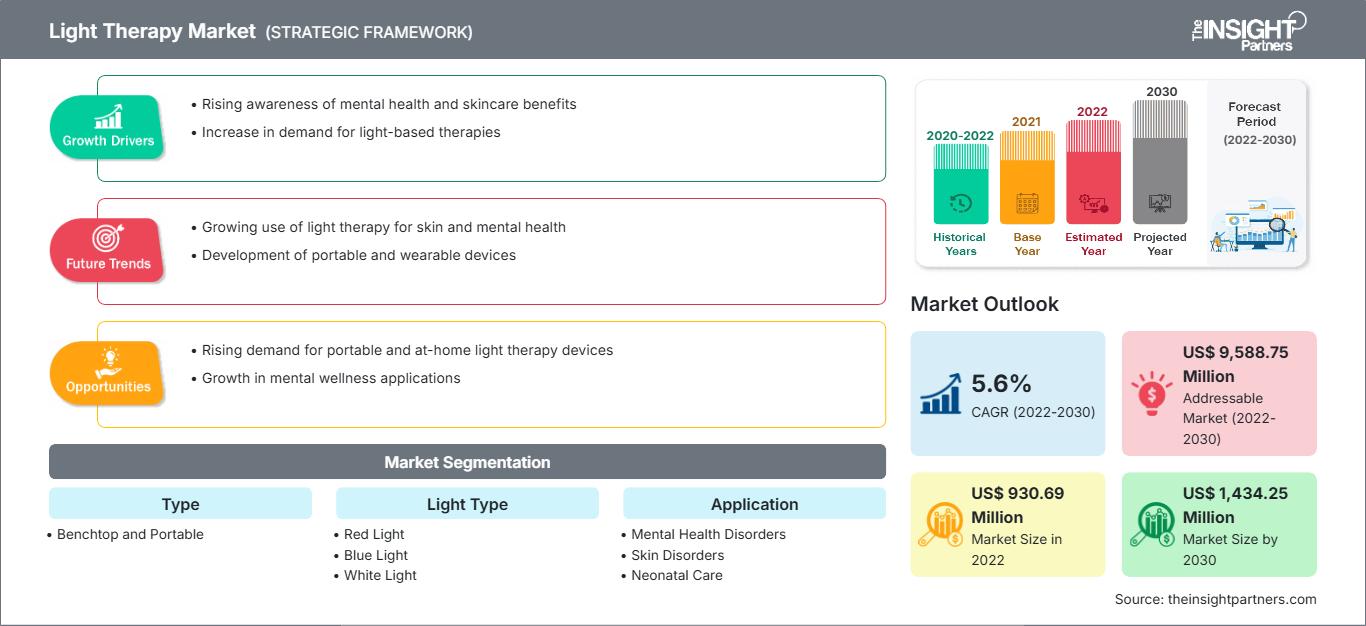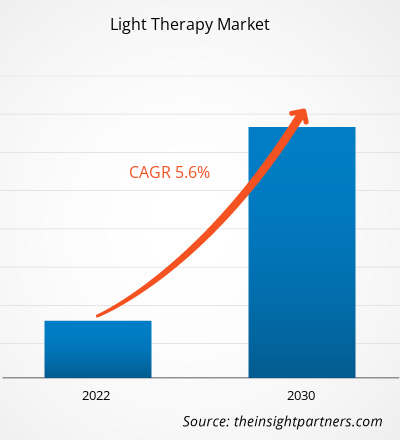[Rapporto di ricerca] Si prevede che il mercato della fototerapia crescerà da 930,69 milioni di dollari nel 2022 a 1.434,25 milioni di dollari entro il 2030; si prevede che il mercato registrerà un CAGR del 5,6% dal 2022 al 2030.
Approfondimenti di mercato e punto di vista degli analisti:
La fototerapia, nota anche come fototerapia, è l'uso terapeutico di specifiche lunghezze d'onda della luce per trattare una serie di condizioni, tra cui disturbi dermatologici, disturbi dell'umore e problemi legati al sonno. Questa modalità di trattamento non invasiva sfrutta le proprietà uniche della luce per suscitare risposte biologiche all'interno del corpo, spesso mirate alla pelle o alla retina, oltre a influenzare i ritmi circadiani e i percorsi di regolazione dell'umore. La fototerapia può comprendere diverse forme, come la terapia con luce blu per l'acne, la terapia con luce rossa per il ringiovanimento cutaneo e la terapia con luce intensa per il disturbo affettivo stagionale.
Fattori di crescita e sfide:
La crescente adozione della terapia con luce blu per le patologie della pelle è emersa come un fattore determinante che ha spinto la crescita e la diversificazione del mercato della fototerapia. La terapia con luce blu, una modalità di fototerapia non invasiva, ha visto un crescente utilizzo per il trattamento di diverse patologie dermatologiche, tra cui acne, psoriasi, eczema e cheratosi attinica. L'efficacia della terapia con luce blu nel trattare specifici problemi cutanei, come l'acne vulgaris, ha ottenuto ampia attenzione e accettazione tra gli operatori sanitari e i soggetti alla ricerca di opzioni di trattamento non farmacologiche. Le innovazioni tecnologiche hanno ulteriormente ampliato l'applicazione della terapia con luce blu, con conseguente sviluppo di sistemi di erogazione della luce specializzati con lunghezze d'onda della luce blu ottimizzate che mirano selettivamente e mitigano le cause sottostanti le patologie dermatologiche. Anche l'accessibilità ai dispositivi per la terapia con luce blu per uso domestico ha contribuito all'espansione del mercato, consentendo alle persone di affrontare i problemi della pelle con soluzioni pratiche e intuitive.
D'altro canto, la terapia della luce offre una serie di benefici terapeutici; tuttavia, il rischio di effetti collaterali associato a determinate modalità è emerso come un fattore limitante per la crescita complessiva del mercato della terapia della luce. Le preoccupazioni relative ai potenziali effetti collaterali, come irritazione cutanea, affaticamento degli occhi e alterazione dei ritmi circadiani, hanno suscitato cautela sia tra gli operatori sanitari che tra i potenziali utenti. Queste preoccupazioni possono dissuadere le persone dall'esplorare le opzioni di terapia della luce, in particolare nei casi in cui non vi siano informazioni o linee guida sufficienti per un utilizzo sicuro e appropriato. Inoltre, la necessità di una dosimetria meticolosa e dell'aderenza ai protocolli di trattamento, unitamente al potenziale rischio di reazioni avverse in soggetti sensibili, rappresenta un ostacolo alla diffusione della terapia. Attenuare questi rischi attraverso la ricerca continua, la formazione e lo sviluppo di misure di sicurezza migliorate sarà fondamentale per affrontare queste limitazioni e promuovere una maggiore fiducia nella sicurezza e nell'efficacia della terapia della luce, incoraggiandone così un utilizzo più ampio e contribuendo alla crescita del mercato.
Personalizza questo rapporto in base alle tue esigenze
Potrai personalizzare gratuitamente qualsiasi rapporto, comprese parti di questo rapporto, o analisi a livello di paese, pacchetto dati Excel, oltre a usufruire di grandi offerte e sconti per start-up e università
Mercato della terapia della luce: Approfondimenti strategici

-
Ottieni le principali tendenze chiave del mercato di questo rapporto.Questo campione GRATUITO includerà l'analisi dei dati, che vanno dalle tendenze di mercato alle stime e alle previsioni.
Segmentazione e ambito del rapporto:
Il mercato della fototerapia è segmentato in base a tipologia, tipo di luce, applicazione e utente finale. In base alla tipologia, il mercato è suddiviso in dispositivi da banco e portatili. Il mercato della fototerapia è segmentato in base al tipo di luce in luce rossa, blu e bianca. In base all'applicazione, il mercato è segmentato in disturbi di salute mentale, disturbi della pelle, ittero neonatale e altri. In termini di utente finale, il mercato è suddiviso in ospedali e cliniche specialistiche, assistenza domiciliare e altri. In termini geografici, il mercato della fototerapia è segmentato in Nord America (Stati Uniti, Canada e Messico), Europa (Regno Unito, Germania, Francia, Italia, Spagna e resto d'Europa), Asia Pacifico (Cina, Giappone, India, Australia, Corea del Sud e resto dell'Asia Pacifico), Medio Oriente e Africa (Emirati Arabi Uniti, Arabia Saudita, Sudafrica e resto del Medio Oriente e Africa) e Sud e Africa. America Centrale (Brasile, Argentina e resto del Sud e Centro America).
Analisi Segmentale:
In base alla tipologia, si prevede che il segmento portatile nel mercato della fototerapia registrerà il CAGR più rapido dal 2022 al 2030. I dispositivi portatili per la fototerapia hanno rivoluzionato l'accessibilità e la praticità dei trattamenti basati sulla luce, consentendo alle persone di ricevere benefici terapeutici in movimento. Queste soluzioni portatili comprendono una gamma di dispositivi, tra cui light box compatte, visori luminosi indossabili e bacchette luminose portatili, progettati per fornire fototerapia mirata in diversi contesti. La portabilità di questi dispositivi consente agli utenti di integrare perfettamente la fototerapia nelle loro routine quotidiane, sia a casa, sul posto di lavoro o in viaggio. Di conseguenza, la fototerapia portatile ha ampliato la portata dei trattamenti basati sulla luce, offrendo alle persone un maggiore controllo sui propri regimi di benessere e migliorando l'aderenza ai protocolli di fototerapia prescritti.
In base alla tipologia di luce, il mercato della fototerapia è segmentato in luce rossa, luce blu e luce bianca. Si prevede che la terapia con luce rossa acquisirà una notevole popolarità nei prossimi anni grazie alla sua capacità di fortificare i mitocondri mediante una reazione biochimica all'interno delle cellule. Pertanto, la terapia con luce rossa ha aumentato la produzione di adenosina trifosfato (ATP), che si dice favorisca lo sviluppo dei capelli, guarisca le ferite, ripari i tessuti e inverta i danni del sole.
Per applicazione, il mercato della terapia con luce rossa è segmentato in disturbi di salute mentale, disturbi della pelle, assistenza neonatale e altri. Il segmento dei disturbi della pelle ospedalieri ha dominato il mercato nel 2022 e si prevede che registrerà un CAGR sostanziale durante il periodo di previsione. L'efficacia della terapia con luce rossa nel trattamento di disturbi della pelle come acne, psoriasi, eczema e dermatite ne ha favorito l'ampia adozione tra gli operatori sanitari e i soggetti che cercano interventi non farmacologici. Questo segmento ha registrato una crescita notevole grazie ai progressi della ricerca che chiarisce gli effetti fotobiomodulatori di specifiche lunghezze d'onda della luce sulle cellule cutanee e sui processi biologici associati.
Analisi regionale:
In base all'area geografica, il mercato della fototerapia è classificato in Nord America, Europa, Asia-Pacifico, Medio Oriente e Africa e America meridionale e centrale.
Il Nord America contribuisce in modo significativo alla crescita di questo mercato a causa del crescente numero di persone affette da psoriasi e sintomi di SAD/depressione invernale; il Nord America ha guidato il mercato mondiale della fototerapia nel 2022. Sotto supervisione medica, il trattamento con la luce comporta l'esposizione della pelle ai raggi UV provenienti da fonti artificiali. I raggi UVB e UVA, o una combinazione dei due, vengono utilizzati per alleviare i sintomi, ridurre l'infiammazione e limitare la proliferazione delle cellule cutanee. La Canadian Dermatology Association ritiene che un milione di canadesi soffra di psoriasi, un fattore chiave che determina la domanda di dispositivi per la fototerapia. Si prevede che il mercato della terapia della luce nell'area Asia-Pacifico registrerà il CAGR più rapido dal 2022 al 2030, grazie agli ingenti investimenti nella telemedicina e alla maggiore conoscenza dei vantaggi della terapia della luce.
Approfondimenti regionali sul mercato della fototerapia
Le tendenze regionali e i fattori che influenzano il mercato della fototerapia durante il periodo di previsione sono stati ampiamente spiegati dagli analisti di The Insight Partners. Questa sezione illustra anche i segmenti e la geografia del mercato della fototerapia in Nord America, Europa, Asia-Pacifico, Medio Oriente e Africa, America Meridionale e Centrale.
Ambito del rapporto di mercato sulla terapia della luce
| Attributo del rapporto | Dettagli |
|---|---|
| Dimensioni del mercato in 2022 | US$ 930.69 Million |
| Dimensioni del mercato per 2030 | US$ 1,434.25 Million |
| CAGR globale (2022 - 2030) | 5.6% |
| Dati storici | 2020-2022 |
| Periodo di previsione | 2022-2030 |
| Segmenti coperti |
By Tipo
|
| Regioni e paesi coperti |
Nord America
|
| Leader di mercato e profili aziendali chiave |
|
Densità degli operatori del mercato della terapia della luce: comprendere il suo impatto sulle dinamiche aziendali
Il mercato della fototerapia è in rapida crescita, trainato dalla crescente domanda degli utenti finali, dovuta a fattori quali l'evoluzione delle preferenze dei consumatori, i progressi tecnologici e una maggiore consapevolezza dei benefici del prodotto. Con l'aumento della domanda, le aziende stanno ampliando la propria offerta, innovando per soddisfare le esigenze dei consumatori e sfruttando le tendenze emergenti, alimentando ulteriormente la crescita del mercato.

- Ottieni il Mercato della terapia della luce Panoramica dei principali attori chiave
Sviluppi del settore e opportunità future:
Di seguito sono elencate alcune iniziative intraprese dai principali attori che operano nel mercato globale della fototerapia:
- A settembre 2023, AMIRO, fornitore leader di soluzioni tecnologiche per la cura della pelle e la bellezza, ha presentato due dei prodotti più all'avanguardia dell'anno: il dispositivo rassodante AMIRO S2 SEAL e il dispositivo di bellezza per il viso con luce LED AMIRO LumoMax.
- A giugno 2022, BioPhotas, Inc. ha stretto una partnership con Ulta Beauty. Con l'ausilio dei modelli Celluma PRO e Celluma ELITE, si prevede che questa collaborazione soddisferà le esigenze di cura della pelle dei clienti in 55 aree distinte negli Stati Uniti. La FDA ha approvato questi modelli per il trattamento di diverse patologie, tra cui rughe, dolori articolari e acne.
Panorama competitivo e aziende chiave:
Koninklijke Philips NV; Beurer GmbH; BioPhotas; Northern Light Technologies; Lumie; Verilux, Inc; Zepter International; The Daylight Company; Zerigo Health; e Naturebright sono tra i principali attori del mercato della fototerapia. Queste aziende si concentrano sull'ampliamento della propria offerta per soddisfare la crescente domanda dei consumatori in tutto il mondo. La loro presenza globale consente loro di servire numerosi clienti, consentendo loro di espandere la propria quota di mercato.
- Analisi storica (2 anni), anno base, previsione (7 anni) con CAGR
- Analisi PEST e SWOT
- Valore/volume delle dimensioni del mercato - Globale, Regionale, Nazionale
- Industria e panorama competitivo
- Set di dati Excel
Report recenti
Testimonianze
Motivo dell'acquisto
- Processo decisionale informato
- Comprensione delle dinamiche di mercato
- Analisi competitiva
- Analisi dei clienti
- Previsioni di mercato
- Mitigazione del rischio
- Pianificazione strategica
- Giustificazione degli investimenti
- Identificazione dei mercati emergenti
- Miglioramento delle strategie di marketing
- Aumento dell'efficienza operativa
- Allineamento alle tendenze normative






















 Ottieni un campione gratuito per - Mercato della terapia della luce
Ottieni un campione gratuito per - Mercato della terapia della luce